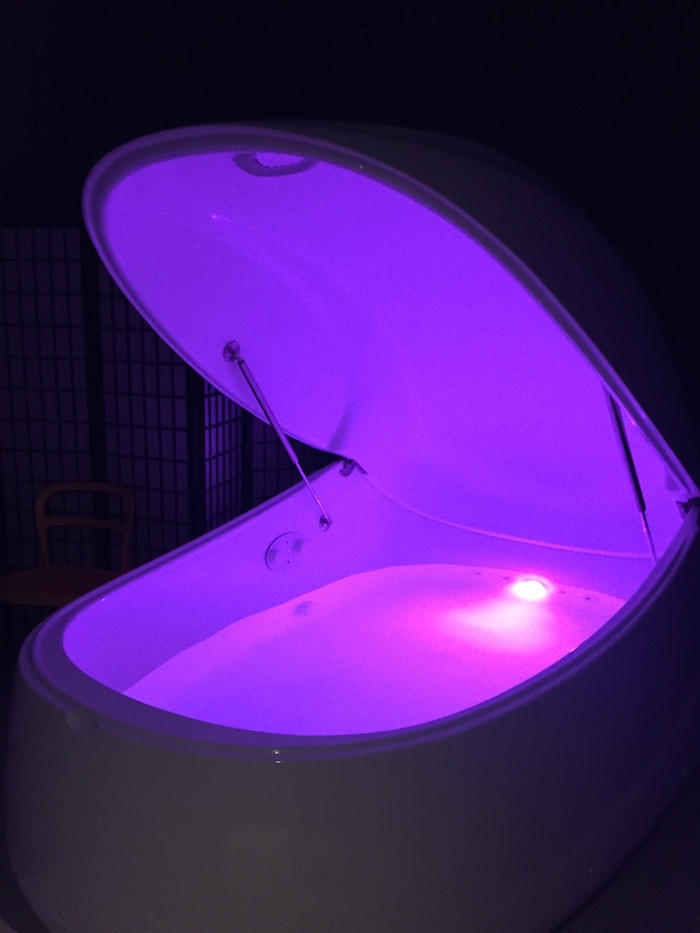
Have you ever floated in a personal black abyss, unaware of the outside world’s drama? I ask because I am not sure if an accessible therapy that deprives the body and mind of excess sensation, opening a chamber of possibility, is publicly known. It is called flotation therapy, or synonymously referred to as sensory deprivation therapy.
Despite floating more than half a dozen times, the most difficult part for me has been accepting the support of the water and physically letting go. Even now, I’m certain it takes a good 20-30 minutes for me to totally trust that my head will effortlessly stay afloat.
My first float kind of went like this:
Okay, shower is done. I’ve entered the tank and am laying here… now what?
Am I doing this right?
I feel like a mermaid. {swoosh left …swoosh right}
Hmm. Is it supposed to have that smell? That’s a lot of salt…
Okay, just breathe and focus on breathing.
{swirling colors appear}
Wow, this is nice.
Ow…oww…owww. My eyes! Crap. It burns.
Okay. Find those colors again.
Lalalala, omg it’s probably only been 10 minutes…
I hope this doesn’t take forever.
I need to relax. What am I rushing for?
{Cue music to indicate the float is over.}
There is no way that was 90 minutes.
And guess what. It was.
So what the heck is flotation? It is the process of entering into a soundproof nine foot tank, void of light, laying down on approximately 10-18 inches of water with dissolved Epsom salt.
Yes, the body is literally floating on this minuscule amount of water. Before my first float, the process was metaphorically described as floating in a personal dead sea. The density provided by the dissolved Epsom salt, allows the opportunity to defy gravity and explore the senses—those which are overwhelmed and dulled throughout the day. My experiences had temperatures ranging from the skin-receptor neutral of 93.5-94 F, and the amount of Epsom salt in the tanks ranged from 850-950lbs.
If questions are popping up including whether this fits or not, and I know I had 1,000,000 questions, reach out to a local float spa—there are more around than thought. It is well known that float therapy benefits have been studied and examined by universities, and medical centers since 1954.
But here are three reasons why floatation therapy should be given a chance:
1. Relaxation: Yes, flotation is pegged as relaxing. Personally, I prefer to know the why and how. How can floating in a bunch of salt be relaxing? Well, through a bit of research I found that the technique hones in on the natural inclination to relax—when floating at a comfortable temperature. This allows natural heat generation to escape without the need for muscle action to raise body temperature in homeostasis.
While floating, typically in the supine position allows all postural muscles to relax. The water pressure on the immersed skin is lower than the blood pressure and thus blood flow continues in skin capillaries. Brain activity normally associated with postural muscles is reduced to a minimum. In this state, natural endorphins are released, reducing pain. [1]
2. Stress Relief/Rehab: According to researchers from the Medical College of Ohio, floatation therapy relieves stress, anxiety and can help with depression. Research studies at the University of British Columbia indicate floating delivers general relaxation, stress reduction, pain relief, and reduced muscle tension. Research by the National Institute of Mental Health indicates floating can help treat hypertension and reduce stress related hormones. As mentioned above floating allows physiological relaxation and allows the body to balance itself; balancing hormones aiding in therapy. Also not having control or sense to worry about anything for an hour and half because time is passing while floating in a tank is rather stress relieving as well.
Lactic acid removal is accelerated, and flow in the lymphatic system is increased. Evidence suggests floating relieves the pressure of gravity from joints and muscles, putting your entire body in an elevated state of physical relaxation. Sports psychologists are aware of the benefits of regular relaxation; it balances the autonomous nervous system, reduces stress and anxiety. Studies indicate that floating may speed up recovery from injury and assist in the flushing of lactate, cortisone and adrenaline due to overtraining. [2]
3. Mental focus: I have dubbed my time during sensory deprivation therapy as floating yoga. Typically, my mat acts as my mirror; an opportunity to flow through asanas and face my stuff. Floating takes away the distraction of noise and visuals, thus leaving you stuck with yourself—vulnerable and alone. While floating an unearthing occurs, if we are open to it. Like yoga, it takes an acceptance of oneself and letting go to learn.
When it comes down to it, floating is an opportunity to retreat, relax and release; something as a go-go-go society, we are not familiar with. Like all great things, practice makes for an enhanced experience. If given the opportunity, why wouldn’t one float it all away?
~
Sources:
- Anette Kjellgren, 2003, The experience of floatation REST (restricted Environmental stimulation technique), subjective stress and pain, Goteborg University Sweden,| Kjellgren A, Sundequist U, et al. “Effects of flotation-REST on muscle tension pain”. Pain Research and Management 6 (4): 181–9.
- Dr R H Waring, 2004, Report on the absorption of magnesium sulfate (Epsom salts) across the skin, School of bio-sciences, Univ of Birmingham B15 2TT, UK
~
Author: Bridget Dwyer
Image: Author’s Own
Editor: Travis May











Read 0 comments and reply